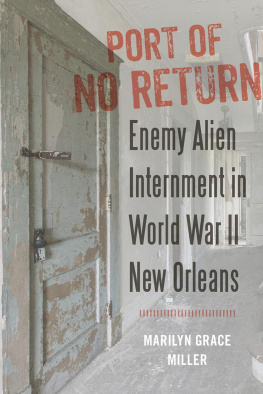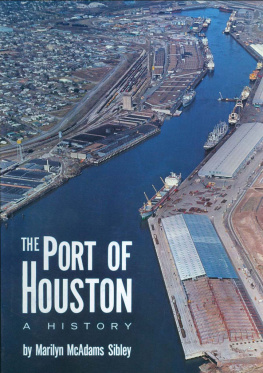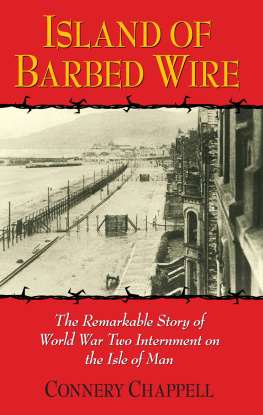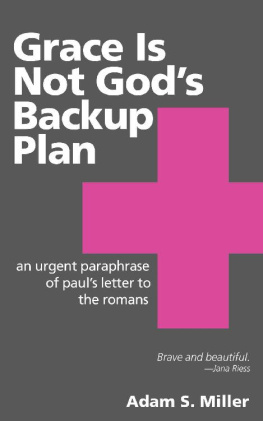Published by Louisiana State University Press
www.lsupress.org
Copyright 2021 by Louisiana State University Press
All rights reserved. Except in the case of brief quotations used in articles or reviews, no part of this publication may be reproduced or transmitted in any format or by any means without written permission of Louisiana State University Press.
LSU Press Paperback Original
DESIGNER : Mandy McDonald Scallan
TYPEFACE : Whitman
Portions of the introduction first appeared, in somewhat different form, in Lessons for the Present from the Alien Enemy Act and the Deportation of Latin Americans to the United States during World War II / Lecciones para el presente que deja la Ley del Extranjero Enemigo y la deportacin de latinoamericanos a Estados Unidos durante la Segunda Guerra Mundial, Tabula rasa 33 (2020): 20124.
Cover photo: Building at the former Camp Algiers. Photo taken in 2017. David Bulit / Shutterstock.com.
Library of Congress Cataloging-in-Publication Data
Names: Miller, Marilyn Grace, author.
Title: Port of no return : enemy alien internment in World War II New Orleans / Marilyn Grace Miller.
Description: Baton Rouge : Louisiana State University Press, 2021. | Includes bibliographical references and index.
Identifiers: LCCN 2020039701 (print) | LCCN 2020039702 (ebook) | ISBN 978-0-8071-7527-9 (paperback) | ISBN 978-0-8071-7535-4 (pdf) | ISBN 978-0-8071-7536-1 (epub)
Subjects: LCSH: Camp Algiers (Algiers, New Orleans, La.) | World War, 19391945Concentration campsUnited States. | World War, 19391945Prisoners and prisons, American. | World War, 19391945LouisianaNew Orleans. | AliensLouisianaNew Orleans. | Algiers (New Orleans, La.)History20th century.
Classification: LCC D805.5.A425 M55 2021 (print) | LCC D805.5.A425 (ebook) | DDC 940.53/1776335dc23
LC record available at https://lccn.loc.gov/2020039701
LC ebook record available at https://lccn.loc.gov/2020039702
Contents
CHAPTER
New Orleanss (Mostly) Secret Internment History
CHAPTER
The Quandaries of Classification
CHAPTER 3.
Incarceration or a Welcome Refuge? The Panama Jews at Camp Algiers
CHAPTER 4.
Professor, Spy, Confidant: Three Notables Interned in New Orleans
CHAPTER 5.
Royals and Nobles behind Barbed Wire
CHAPTER 6.
Aid Organizations, Diplomatic Efforts, and Community Allies
Preface
A Surprising Piece of the Citys Past
On November 9, 2016, the day after the 2016 presidential election, I stood with producer Laine Kaplan-Levenson just outside the locked security gates of a border patrol station in the Algiers neighborhood on the West Bank of the Mississippi River in New Orleans, Louisiana. After learning of the stations use as an Immigration and Naturalization Serviceadministered enemy alien detention camp during World War II, I had contacted Kaplan-Levenson about creating a segment on the site for the series TriPod: New Orleans at Airing weekly on local public radio station WWNO from October 2015 to October 2018, TriPod offered fresh radio history about New Orleans in the lead-up to its 2018 tricentennial. Each TriPod segment moved beyond the familiar themes of New Orleans history to focus on forgotten, neglected, or surprising pieces of the citys past, and to enrich understanding of its present and future. It seemed the perfect venue for the weird, incredible tale of enemy aliens being housed in the Crescent City during wartime.
Kaplan-Levenson and I had studied anecdotal references to the Algiers Detention Station in accounts by historians such as Max Paul Friedman and Harvey Strum. I had already compiled a starter bibliography and brought with me copies of local news articles from 1943 to 1946 that referred to the detention station, one of which even featured a photo taken soon after its decommissioning as an internment station. That photo, which ran on the front page of the Times-Picayune on March 30, 1946, with the headline Close Pal of Hitler Held in Algiers Detention Unit, confirmed we were, in fact, standing at the very spot on the Mississippi River levee from which the site had been photographed for posterity seventy years earlier. The photo and accompanying headline also posed some big questions. Was someone from Hitlers inner circle in fact detained at the Algiers facility during World War II? If so, who was this mysterious person whose name was not revealed in the article? Why was he held here? Such details suggested a vital if buried episode in the citys rich and complex history. The celebration of New Orleanss tricentennial in 2018 provided an opportune moment for uncovering this shadowy chapter of a global story from a local vantage point.
When we requested entry to the facility in order to investigate further, there was a pregnant pause from the voice on the other end of the Customs and Border Patrol intercom; you could almost hear the head scratching. Referred to the US Border Patrols information officer, Robert Rivet, we later found that neither he nor anyone else then working at the former quarantine station knew of this episode in the facilitys past or had even heard of it. In the face of their skepticism, we might have given up. Hadnt reputed historians already done admirable scholarship on the broader topic of World War II enemy alien internment across the United States, though none had focused in particular on New Or
leans? Nonetheless, we agreed the Camp Algiers story merited further attention, perhaps even more so, given the aura of mystery and secrecy surrounding it and the fact that topics such as the enemy nature of aliens seeking asylum and New Orleanss role as a sanctuary city were much in the news.
Kaplan-Levenson produced two segments that first aired on TriPod on January 12 and 19, 2017, and on many subsequent occasions as well. Part 1 provided the general history of the Department of States Enemy Alien Control Program, implemented immediately after the bombing of Pearl Harbor. That first segment included audio commentary from Friedman, Strum, myself, and Nancy Corts Reinbold, a Honduran whose German-born grandfather, Fritz Reinbold, was detained in Tegucigalpa and deported to New Orleans for US internment. He was later confined at a camp in Crystal City, Texas, along with his wife and children, including Nancys mother, Ingrid, less than a year old at the time. An employee of the German embassy when apprehended, Reinbold had likely been named an enemy alien because he was rich rather than for any political activity, his granddaughter told Kaplan-Levenson. The deportation allowed for the Honduran governments appropriation of Reinbolds property and assets.
This material injustice was layered with another tragic loss that I later uncovered in my research. The Reinbolds three-year-old son, Edgar, born in Honduras in 1941, died at the Crystal City internment camp of internal injuries after being hit by a truck there in May 1944. His gravestone at the Edgewood Cemetery in Crystal City bears the inscription In Liebe deine Eltern, or With love, your parents. Learning of personal experiences like those of the Reinbolds spurred me to look for the human stories at the heart of this history, to flesh out, as it were, the decisions, policies, events, places, and paperwork that governed the operation of the Enemy Alien Control Program at the local level.
Part 2 of the TriPod podcast on Camp Algiers served as a kind of teaser for this approach by focusing on everyday life for the internees in New Orleans. The podcast remarked on the stations erstwhile designation as a Camp of the Innocent, thanks to the arrival in 1943 and after of many anti-Nazi detainees, including about sixty Jewish men, women, and children who were transferred from camps where they faced harassment and violence from pro-Nazi, pro-Fascist and/or antisemitic detainees. Discovering that about eighty Jews were among the enemy aliens apprehended in Latin America as Nazi or Axis sympathizers (or at least potential subversives) was a veritable assault to credulity, but learning these individuals and families were ultimately congregated at Camp Algiers further piqued my curiosity and compelled me to continue the research.








